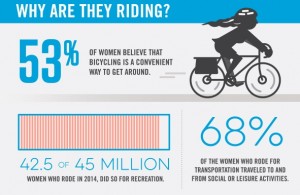Women’s cycling participation – the latest research
 I’m always interested in research relating to women’s cycling. It helps me and others understand what barriers women see to cycling. Is it the lack of safe places to ride? Is it the blokey bike shops? Is it that they have to wear a helmet even for a short trip? (in Australia where I live helmets are mandatory for any type of bike).
I’m always interested in research relating to women’s cycling. It helps me and others understand what barriers women see to cycling. Is it the lack of safe places to ride? Is it the blokey bike shops? Is it that they have to wear a helmet even for a short trip? (in Australia where I live helmets are mandatory for any type of bike).
A US group called PeopleForBikes commissioned the US Bicycling Participation Study in late 2014. They measured all kinds of riding by all kinds of people, including women. Here are six important and interesting findings from the study:
1. The gap between men and women isn’t so large
They surveyed more than 16,000 individuals and weighted that sample to represent the US population and found that 104 million people—a third of the population—rode a bicycle last year and of those, 45 million (43%) were women compared to 59 million men (57%). The findings revealed less of a gender gap than the 2009 National Household Travel Survey which (using a different methodology) found that just 24% of bicycle trips were made by women.
2. Most women ride for recreation
They asked participants to tell them whether they ride for recreation or transportation and found that 95% of the 45 million women who rode in 2014, did so for recreation. Nearly two-thirds of women who bike, ride only for recreation. And among women who do ride for transportation, the most popular types of transportation trips, coming in at 68%, were related to social or leisure activities.
3. Parents ride more
Having kids does not interfere with bike riding for men or women. Rather, women with children ride at a higher rate than those without (32% vs. 19%), as do men (47% with children vs. 31% without).
4. Men and women have similar bike-related aspirations
Men and women have similar goals when it comes to riding bikes. Both men and women said they want to bike more often (54% and 52% respectively) and similar numbers reported that their frequency would rise with an increase in protected bike lanes. Everyone wants to ride more, and they want more safe places to do it.
5. The gap widens on safety concerns
Fifty-four percent of women, including those who did not ride in 2014, expressed a fear of being hit while bicycling, compared with 49% of men. Women also worry more than men about their overall personal safety in areas where they ride. Another issue facing women at a higher level is the availability of a bike: Only 49% of women reported having a working adult bicycle in their home, compared to 55% of men.
6. Older girls and women ride less
In addition to gender, the study also broke down bicycling participation by age. They found that the gap between men and women riding continues to widen as they grow older. From ages 3 to 9, boys and girls ride at same rate, but starting at age 10, there’s a significant drop off for girls. That gap continues to grow, and is at its widest among men and women ages 55 and older.
For me this is a really interesting study and although it is US research, much of it applies to Australia and I’m sure other countries. Thanks for sharing your research with us PeopleforBikes.
You can download the entire study at http://www.peopleforbikes.org/pages/u.s.-bicycling-participation-benchmarking-report
